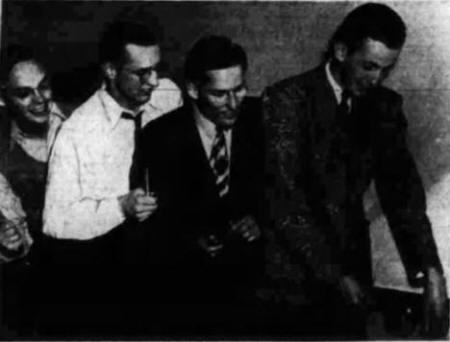

Partner Theodoros Stamos
Queer Places:
University of Utah, 201 South 1460 East, 201 Presidents Cir, Salt Lake City, UT 84112
346 Sutter St, San Francisco, CA 94108
Museum of Moden Art (MoMA), 11 W 53rd St, New York, NY 10019
Provo City Cemetery
Provo, Utah County, Utah, USA
 Robert
Glenn Price (March 6, 1918 - October 29, 1954) was an American poet. His
partner was painter Theodoros Stamos. In 1948,
Stamos traveled with Price to Europe for the first time, visiting France, Italy and Greece (the birthplace of his parents).
Robert
Glenn Price (March 6, 1918 - October 29, 1954) was an American poet. His
partner was painter Theodoros Stamos. In 1948,
Stamos traveled with Price to Europe for the first time, visiting France, Italy and Greece (the birthplace of his parents).
Robert Glenn Price was born in Heber City, Utah. He attended University of Utah and was the editor of the Pen in 1939. He served during WWII as a Sergeant with the Army Air Forces.
At the death of Price in 1954, Stamos donated 10 paintings to the MoMA: $20,750 Bougainvillea by Price himself; Reclining Figure (1949), by Joseph Glasco; Study (1947), by Herbert Ferber; Greek Boats (ca. 1954), by Anne Poor; Dancing Figures (1946), by Eugene Berman; Male Cat (1951), by Joseph Glasco; Still Life (1924), by Preston Dickinson; Battle (1942), by Mark Tobey; Autumn Color (ca. 1910), by Marsden Hartley; Landscape (ca. 1950), by John Heliker.
Harold Norse was Dwight Ripley's obsession of the 1951 season, and Norse was richly rewarded by him with the gift of an expensive Picasso that made it possible for him to move to Italy. Fidelity was not a Norse characteristic; as Rupert Barnaby, Ripley's longtime partner, later said, "Dwight is not a griever or a whiner. Gone are the snows of yesterdays." Norse portraied Dwight in his memoirs as the millionnaire "Cyril Reed". Norse had an apartment at 573 Third Avenue, where he lived one floor above a New Zealand painter, Glyn Collins (for a short time in 1945 the husband of Muriel Rukeyser), who was commissioned by Dwight Ripley to paint a portrait of Tony Bower. When Collins gave a party he invited his upstairs neighbor Norse. Other guests that evening included the painter-and-poet couple Theodoros Stamos and Robert Price; the Abstract Expressionist painter William Baziotes and his wife, Ethel; the Living Theatre's founders-to-be Julian Beck and Judith Malina; the social philosopher Paul Goodman and his wife, Sally; John Bernard Myers and his roommate, Waldemar Hansen; the poet Ruthven Todd; and Dwight and Rupert. Dwight, reports Norse in his memoirs, was drunk, fell for him with a "thud heard round the room," and before passing out inquired what he most wanted. Norse had no way of knowing that Dwight a decade earlier had complained, "I long to say just $20." No doubt he did know, but way of Chester Kallman and W. H. Auden, the story of Denham Fouts and the liquidated Picasso given to him by Peter Watson. "Taking it as a big joke," writes Norse, "I blurted out with drunken laughter, "How about a Picasso?" "Is that all?" he screamed. "Daahling, it's yours!" A few days after the party a limousine arrived on Third Avenue, and the surprised Norse opened his door to find a chauffeur, in uniform, who had come to dliver a 1923 Picasso gouache, a ten-by-sixteen-inch study for The Dancers, certified by Pierre Matisse. In his memoirs, Norse gives a vivid account of the ensuing affair (dinners at Le Pavillon and Chambord, trips to the galleries, visits to the New York Public Library, where Dwight read War and Peace in Arabic), and he reveals also that his new admirer never touched him. He credits the forbearance to his own virtue and not to Dwight's. It all came to an end on a winter evening outside the Chelsea Hotel. "He had told me earlier," recalled Norse, "because he was a masochist, if you ever want to get rid of me, and you'll never see me again, just say "I love you" and you'll never see me again. So outside this hotel he said, "Harold, do you love me?" and I said, "Yeah," and I never saw him again." The previous autumn, Ripley recorded in his diary that Norse and Norse's lover during the whole affair, Dick Stryker, were going to Wappingers Falls, Ripley's country house in Upstate New York, to spend the weekend. He made a not to get his drawings down from upstairs. Fifty years later, when Douglas Crase, Ripley's biographer, asked Norse by telephone what he thought of Dwight's drawings, he replied, "I never knew Dwight could draw or would even bother to do something artistic. Dwight an artist, no, I had no idea. I can't believe it."
My published books: